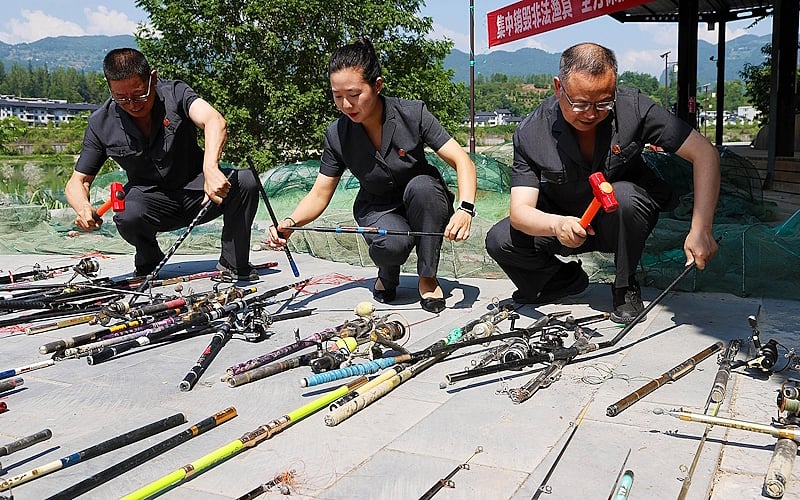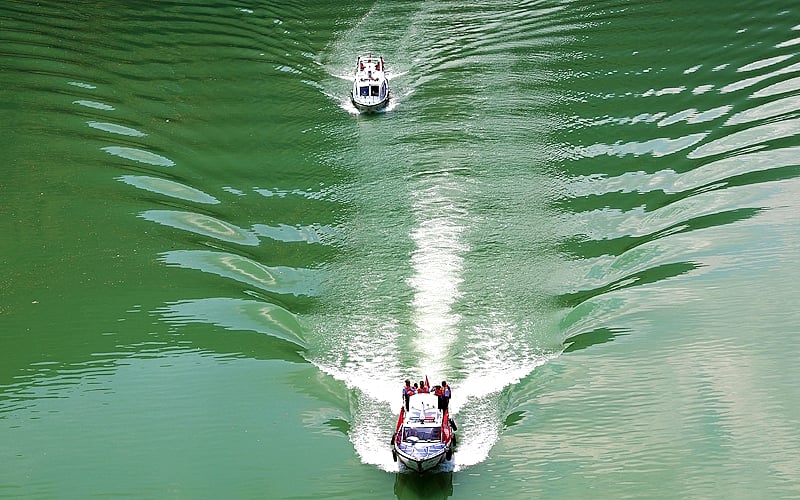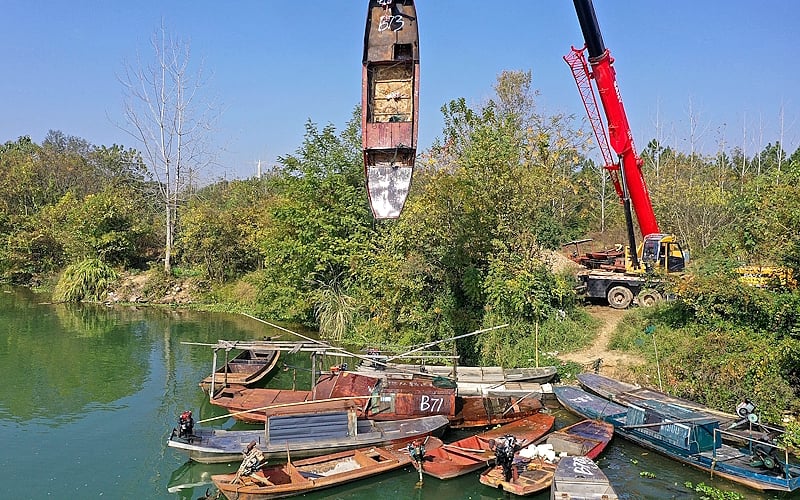
Born in De’an, a county near Poyang Lake along the Yangtze River in Jiangxi province, Wei Qiwei, chief scientist at the Chinese Academy of Fishery Sciences, has vivid childhood memories of water and fish.
The 64-year-old used to play in a small river near his home from the age of 3.
“For us kids, the river was a place of comfort and fun. We couldn’t live without it,” he smiled.
More important was that the river provided his favourite food — fish.
His grandfather was a fisherman who fished with the help of trained cormorants.
“The bird could easily catch fish as there were quite a lot of fish back then.”
In stark contrast to his childhood, however, Wei described the remarkable fish scarcity he encountered when he first surveyed the Yangtze from 2017 to 2020 as chief scientist.
“Fishermen hardly had any catch. The money they made from selling fish was barely enough to cover the cost of the fuel,” he said, noting that he was deeply concerned about the conservation situation at the time.
A total of 323 fish species were found in the river, with 135 historically distributed in the Yangtze undiscovered, according to the Ministry of Agriculture and Rural Affairs, which funded the survey.
A few years on, Wei is somewhat relieved because of a 10-year fishing moratorium that came into effect in the Yangtze River Basin on Jan 1, 2020, which is part of a national campaign to promote Yangtze conservation.
Aside from the fishing ban, a series of measures have been taken to conserve fish resources in the basin following a symposium presided over by President Xi Jinping in Chongqing on the issue in January 2016.
The president stressed that concerted efforts should be made to protect the Yangtze, and that the overdevelopment of the river should be banned.
Xi hosted three more symposiums concerning the high-quality development of the Yangtze River Basin thereafter, with the first held in Wuhan in April 2018.
At that symposium, the president emphasized properly dealing with the relationship between environmental protection and economic development.
Wei lauded the decision to promote concerted efforts in Yangtze conservation as one “with farsightedness and vision”, as fish conservation is not something that can be done by a single institution or government body, and needs participation from all walks of life.

Illegal fishing curbed
Relevant authorities at different levels have come down hard and are maintaining intense pressure on illegal fishing since the moratorium came into effect, according to the Ministry of Agriculture and Rural Affairs.
Over the past three years, agricultural and rural authorities and public security organs at different levels have handled over 1,600 administrative cases and more than 500 criminal cases related to fishing, it said.
On average, it said different levels of administration for market regulation handled more than 300 relevant cases every month.
The ministry also noted significantly strengthened law enforcement capabilities have been used to ensure the full implementation of the moratorium.
The number of licensed fishery law enforcement officers in regions along the Yangtze has reached 10,400, four times more than before the moratorium, it said, adding all key waters in the mainstream of the Yangtze, its estuary and Poyang and Dongting lakes have been covered by surveillance cameras.
“In 2023, the number of reports from the public about illegal fishing decreased by 28 percent compared to the previous year. The trend of frequent incidents of illegal fishing has been effectively curbed,” it said.
To enhance the conservation of fish, especially endangered species, many projects previously built along the country’s longest watercourse have been relocated.
Built in 1958, for instance, the Wangjiahe oil depot in Yichang, Hubei province, used to be the largest reserve base for refined oil in western Hubei, handling 13 billion metric tons of refined oil every year.
The depot, the wharf of which is located in a section of the Yangtze that Chinese sturgeon must pass in their breeding migration, has been moved to a new location about 60 kilometres away.
Listed as “critically endangered” by the International Union for Conservation of Nature, Chinese sturgeon are endemic to China and are under national first-class protection.
The fish is one of the world’s oldest living species, dating back to the days of the dinosaurs some 140 million years ago.
A wharf with the depot is still there along the Yangtze. But now it works as a facility to disseminate knowledge about Chinese sturgeon protection.
According to Sinopec Marketing Hubei, the Wangjiahe depot is just one of 11 depots the company has relocated to help with Yangtze conservation.
It has also shut down 17 shipping docks and 12 floating fueling stations along the Yangtze, said Wang Baosheng, deputy Party chief of the company.
In a move also aimed at protecting the Chinese sturgeon, investors in the Wujiagang Yangtze Bridge in Yichang changed the design of the structure before its construction started in late 2016, despite that it would significantly increase costs.
Situated 15 km downstream of the Gezhouba Dam hydropower project, the bridge lies in the core area of the zone for Chinese sturgeon conservation and a breeding and habitat area for the species.
The bridge, as tall as a 50-story building, was originally designed with two piers erected in the middle of the Yangtze.
With low cost, however, such a design needs a lot of construction work in and over the water, and that would inevitably result in water, light and noise pollution, disturbing Chinese sturgeon in the area, according to China Communications Construction Company Second Harbour Engineering Co, one of the investors.
In the new design, no piers were constructed in Yangtze waters.
But that meant that the main cables of the bridge needed to be thickened and anchorage points also needed to be increased, bringing up the cost by about 100 million yuan (RM60.8 million).

Remarkable recovery
Though it has been only over three years since the fishing moratorium was imposed, there have been positive signs that show the recovery of some fish species in the Yangtze.
The location where the Jinsha and Minjiang rivers converge into the Yangtze in Yibin city in Sichuan province is a popular destination for tourists.
It has become even more popular because a large school of wild fish are usually visible there, with some weighing more than 20 kilograms.
“They don’t shy away from crowds,” said Quan Hong, a law-enforcement officer for fisheries management with the agriculture and rural affairs bureau of Xuzhou district, where the river convergence is located.
A recent assessment conducted by the China Institute of Water Resources and Hydropower Research shows that the aquatic biological integrity indexes in the Yangtze’s mainstream, as well as Poyang and Dongting, the only two large lakes that remain naturally connected to the Yangtze, stood at the worst level of having “no fish at all” before the moratorium.
Now, their indexes have all improved by two levels.
There are six levels under the index system with “excellent” being the best level, followed by “good”, “average”, “poor” and “very poor”.
As a professor dedicated to researching fish with the Chinese Academy of Sciences’ Institute of Hydrobiology, Liu Huanzhang has endorsed the improvement of Yangtze’s aquatic biological integrity, noting the Ochetobius elongatus — a type of carp — as an example.
The fish used to be a common species in the Yangtze, but it became rare after the year 2000 and “could hardly be seen”, especially over the decade before the moratorium.
But Liu now finds the species multiple times a year in his fish monitoring and resources surveys of the Yangtze.
Ochetobius elongatus, a demanding fish with carnivorous tendencies, relies heavily on the presence of other fish for its survival, he said.
The dramatic decline in its population this century happened mainly due to overfishing, which has not only directly impacted its numbers but also disrupted its food chain.
“The recovery of the Ochetobius elongatus certainly indicates a recovery of the overall fish stock,” Liu said.
Wei, the scientist, believes that, with the gradual implementation of comprehensive protection measures for the Yangtze, the aquatic ecological environment of the river will significantly improve in the future.
“I can’t wait to see the Yangtze in 2030,” he said, indicating his high expectations to see a significantly positive transformation in Asia’s longest river.

ADVERTISEMENT
ADVERTISEMENT








































